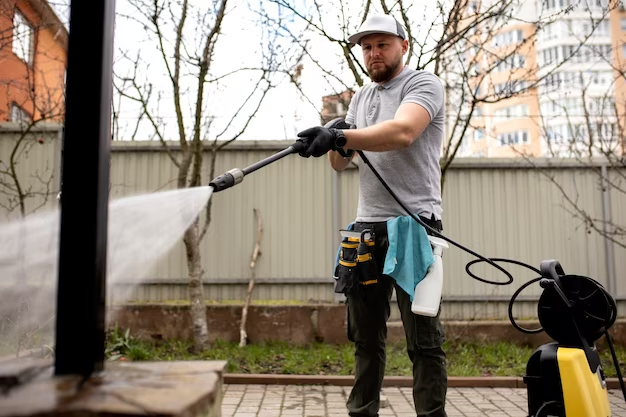Pressure washers are amazing tools. They help clean almost anything, from patios to cars. But here’s the thing: not all pressure washers work the same. The power level of each one matters. It’s the difference between a job well done or a disaster. If you want the right pressure for your cleaning job, you need to understand how it works.
What Is a Pressure Washer PSI?
PSI measures the power of a pressure washer. This stands for Pounds Per Square Inch. The higher the PSI, the stronger the water stream. Think of it as the “muscle” of the washer. A high PSI can blast away tough dirt, grime, and even paint. But, don’t assume higher is always better.
Different jobs need different PSI levels. If you use too much pressure, you could end up damaging your surface. Conversely, using too little pressure won’t get the job done right. It’s all about balance. And trust me, finding that balance can save you a lot of frustration.
Common Pressure Washer PSI Ranges
Here’s a breakdown of the most common PSI levels you’ll see:
- Light-duty (1,300 – 1,900 PSI): This range is great for smaller jobs like washing cars or cleaning outdoor furniture.
- Medium-duty (2,000 – 2,800 PSI): Perfect for cleaning driveways, patios, and your home’s exterior.
- Heavy-duty (2,900 – 3,300 PSI): Best for removing tough stains, stripping paint, or cleaning large areas.
- Extra heavy-duty (3,300+ PSI): Used mostly for industrial work, like cleaning construction equipment.
Why Choosing the Right PSI Matters
So, why does it matter? Well, using the right Pressure Washer PSI Guide keeps your surfaces safe. If the PSI is too high, you could scratch or even destroy the surface. For instance, if you use too much power on your car, you might chip in the paint. On the other hand, if the PSI is too low, you’ll waste time. The dirt will still be there, and you’ll feel like you’ve done nothing.
Different surfaces react differently to pressure. Concrete can handle high pressure, but wood? Not so much. So, matching the PSI to the task is super important.
Light-Duty Pressure Washers: Perfect for Small Jobs
For smaller cleaning jobs, light-duty washers are the way to go. They range from 1,300 to 1,900 PSI. This range is perfect for cleaning things like outdoor furniture, cars, or even grills. They have just enough power to get rid of dirt and grime but are gentle enough to avoid causing damage.
Another great use for light-duty washers is washing windows. They remove dirt and dust without cracking or scratching the glass. Plus, they’re lightweight and easy to use, so you won’t feel exhausted after a small job.
Medium-Duty Pressure Washers: A Step Up in Power
When you have tougher jobs around the house, a medium-duty pressure washer is your best bet. These washers usually have a PSI between 2,000 and 2,800. This extra power makes them ideal for cleaning driveways, sidewalks, and even decks. If you need to wash your house’s exterior, this is the right tool for the job.
However, don’t go wild with the power. These washers are strong, and you need to be cautious when using them on wood or softer surfaces. Always test a small section before going all in.
If you’re looking for a Pressure Washer Trailer Setup, these PSI levels are popular for mobile cleaning units that tackle larger tasks.
Heavy-Duty Pressure Washers: Serious Cleaning Power
Heavy-duty pressure washers bring some serious power. They produce between 2,900 and 3,300 PSI, which is more than enough for tough jobs. This includes tasks like removing old paint, deep-cleaning concrete, and even removing graffiti. You’ll often find these washers used in commercial spaces or for prepping a surface for painting.
But remember, with great power comes great responsibility! Heavy-duty washers can easily damage surfaces if you’re not careful. Avoid using them on delicate materials like cars or soft woods, unless you want to deal with costly repairs.
Extra Heavy-Duty Pressure Washers: Industrial-Grade Power
If you need a pressure washer for industrial tasks, an extra heavy-duty washer is what you want. These bad boys have over 3,300 PSI. That’s enough power to clean large construction equipment or get a surface ready for major renovation work. With this much power, you can clean huge surfaces in very little time.
However, these washers are not for your everyday household jobs. They’re meant for big tasks, like cleaning large parking lots or blasting away layers of grime from brick buildings. Unless you’re in the business of heavy-duty cleaning, an extra heavy-duty washer might be overkill.
How to Match PSI to Different Tasks
Now that you know about the different power levels, let’s look at how to match PSI to specific tasks.
Washing Cars
For washing cars, you want to stick to a light-duty washer. Aim for a PSI of 1,300 to 1,500. It’s gentle enough to avoid scratching the paint but still strong enough to remove dirt.
Cleaning Decks
Decks, especially wood ones, need extra care. Use a medium-duty washer with a PSI of 2,000 to 2,500. This is strong enough to clean off dirt and grime but won’t harm the wood if used properly.
Washing Driveways
Concrete driveways are tough and can handle a higher PSI. For this job, go with a heavy-duty washer, around 2,800 to 3,000 PSI. It’ll blast away oil stains and stubborn dirt with ease.
Removing Paint
When removing paint, you’ll need a heavy-duty washer. Go for a PSI of 3,000 to 3,300 to get the job done quickly. Just be careful not to damage the surface underneath the paint.
PSI and GPM: Finding the Right Balance
PSI is important, but don’t forget about GPM. GPM stands for gallons per minute. It measures how much water your pressure washer uses. A washer with higher GPM cleans faster because it uses more water. But just like PSI, finding the right balance between PSI and GPM gives you the best results.
For example, a washer with high PSI but low GPM might be slower than one with balanced ratings. To clean faster and more efficiently, look for a pressure washer that offers a good mix of both PSI and GPM.
Conclusion: Choose the Right Pressure Washer for the Job
Knowing how pressure washer power levels work is key to getting the best results. Each job requires a different PSI to make sure the surface is cleaned without causing any damage. Whether you’re tackling small tasks like cleaning your car or big jobs like removing paint, choosing the right power level will save you time and stress.
With the right pressure washer, you’ll see that even the toughest cleaning jobs become easier. Now that you’ve got this pressure washer psi guide, you’re ready to pick the right machine for any task you’ve got on your list!




